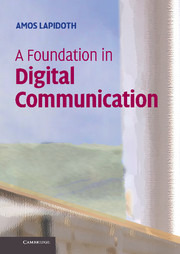Book contents
- Frontmatter
- Contents
- Preface
- Acknowledgments
- 1 Some Essential Notation
- 2 Signals, Integrals, and Sets of Measure Zero
- 3 The Inner Product
- 4 The Space L2 of Energy-Limited Signals
- 5 Convolutions and Filters
- 6 The Frequency Response of Filters and Bandlimited Signals
- 7 Passband Signals and Their Representation
- 8 Complete Orthonormal Systems and the Sampling Theorem
- 9 Sampling Real Passband Signals
- 10 Mapping Bits to Waveforms
- 11 Nyquist's Criterion
- 12 Stochastic Processes: Definition
- 13 Stationary Discrete-Time Stochastic Processes
- 14 Energy and Power in PAM
- 15 Operational Power Spectral Density
- 16 Quadrature Amplitude Modulation
- 17 Complex Random Variables and Processes
- 18 Energy, Power, and PSD in QAM
- 19 The Univariate Gaussian Distribution
- 20 Binary Hypothesis Testing
- 21 Multi-Hypothesis Testing
- 22 Sufficient Statistics
- 23 The Multivariate Gaussian Distribution
- 24 Complex Gaussians and Circular Symmetry
- 25 Continuous-Time Stochastic Processes
- 26 Detection in White Gaussian Noise
- 27 Noncoherent Detection and Nuisance Parameters
- 28 Detecting PAM and QAM Signals in White Gaussian Noise
- 29 Linear Binary Block Codes with Antipodal Signaling
- A On the Fourier Series
- Bibliography
- Theorems Referenced by Name
- Abbreviations
- List of Symbols
- Index
28 - Detecting PAM and QAM Signals in White Gaussian Noise
Published online by Cambridge University Press: 05 June 2012
- Frontmatter
- Contents
- Preface
- Acknowledgments
- 1 Some Essential Notation
- 2 Signals, Integrals, and Sets of Measure Zero
- 3 The Inner Product
- 4 The Space L2 of Energy-Limited Signals
- 5 Convolutions and Filters
- 6 The Frequency Response of Filters and Bandlimited Signals
- 7 Passband Signals and Their Representation
- 8 Complete Orthonormal Systems and the Sampling Theorem
- 9 Sampling Real Passband Signals
- 10 Mapping Bits to Waveforms
- 11 Nyquist's Criterion
- 12 Stochastic Processes: Definition
- 13 Stationary Discrete-Time Stochastic Processes
- 14 Energy and Power in PAM
- 15 Operational Power Spectral Density
- 16 Quadrature Amplitude Modulation
- 17 Complex Random Variables and Processes
- 18 Energy, Power, and PSD in QAM
- 19 The Univariate Gaussian Distribution
- 20 Binary Hypothesis Testing
- 21 Multi-Hypothesis Testing
- 22 Sufficient Statistics
- 23 The Multivariate Gaussian Distribution
- 24 Complex Gaussians and Circular Symmetry
- 25 Continuous-Time Stochastic Processes
- 26 Detection in White Gaussian Noise
- 27 Noncoherent Detection and Nuisance Parameters
- 28 Detecting PAM and QAM Signals in White Gaussian Noise
- 29 Linear Binary Block Codes with Antipodal Signaling
- A On the Fourier Series
- Bibliography
- Theorems Referenced by Name
- Abbreviations
- List of Symbols
- Index
Summary
Introduction and Setup
In Chapter 26 we addressed the problem of detecting one of M bandwidth-W signals corrupted by additive Gaussian noise that is white with respect to the bandwidth W. Except for assuming that the mean signals are integrable signals that are bandlimited to W Hz, we made no assumptions about their structure. In this chapter we study the implication of the results of Chapter 26 for Pulse Amplitude Modulation, where the mean signals correspond to different possible outputs of a PAM modulator. The conclusions we shall draw are extremely important to the design of receivers for systems employing PAM.
The most important result of this chapter is that, loosely speaking, for PAM signals contaminated by additive white Gaussian noise, the inner products between the received waveform and the time shifts of the pulse shape by integer multiples of the baud period Ts form a sufficient statistic. Thus, if we feed the received waveform to a matched filter that is matched to the pulse shape defining the PAM signals, then the matched filter's outputs sampled at integer multiples of the baud period Ts form a sufficient statistic (Theorem 5.8.2). Using this result we can reduce the guessing problem from one with an observation consisting of a continuous-time stochastic process to one with an observation consisting of a discrete-time SP. In fact, since we shall only consider the problem of detecting a finite number of data bits, the reduction will be to a finite number of random variables.
- Type
- Chapter
- Information
- A Foundation in Digital Communication , pp. 634 - 652Publisher: Cambridge University PressPrint publication year: 2009



